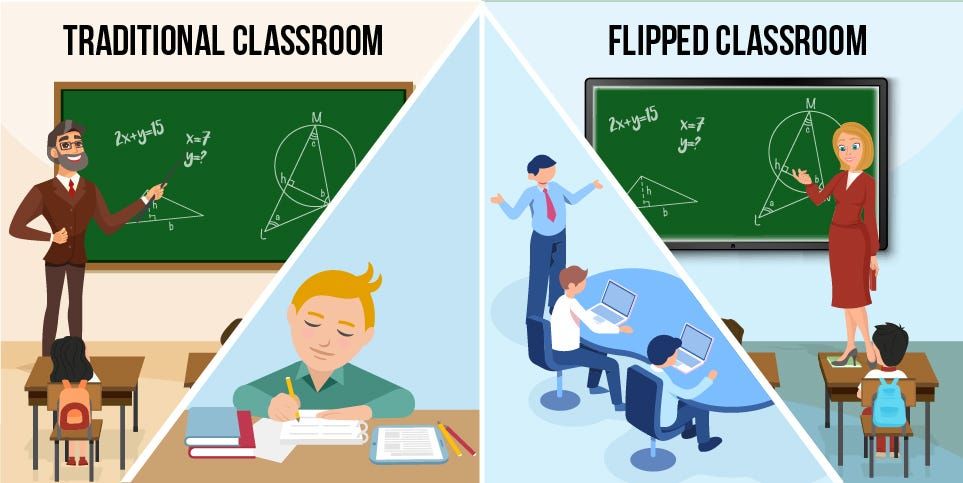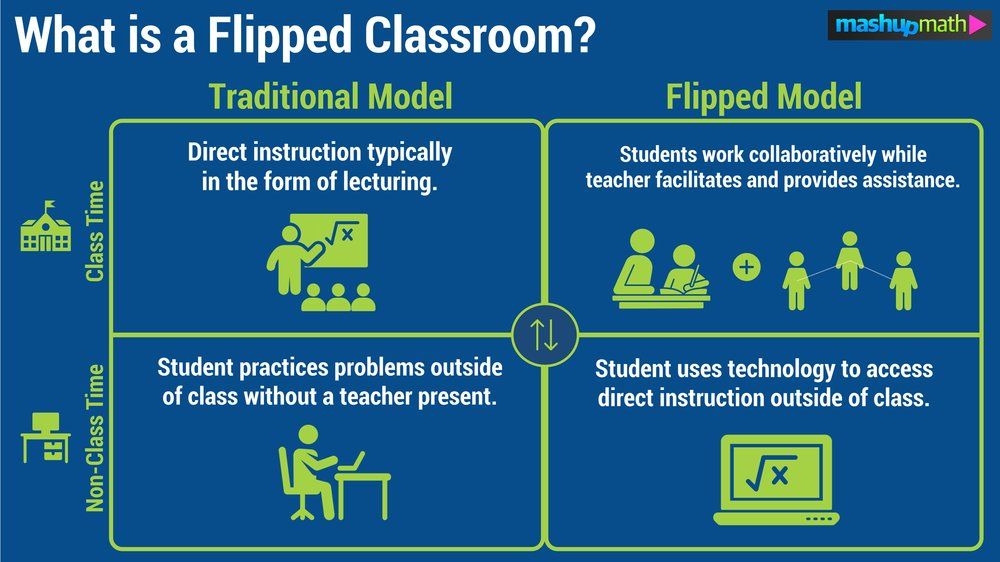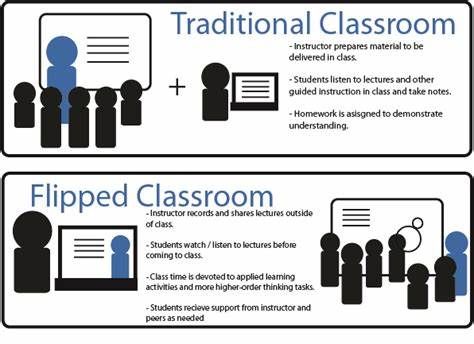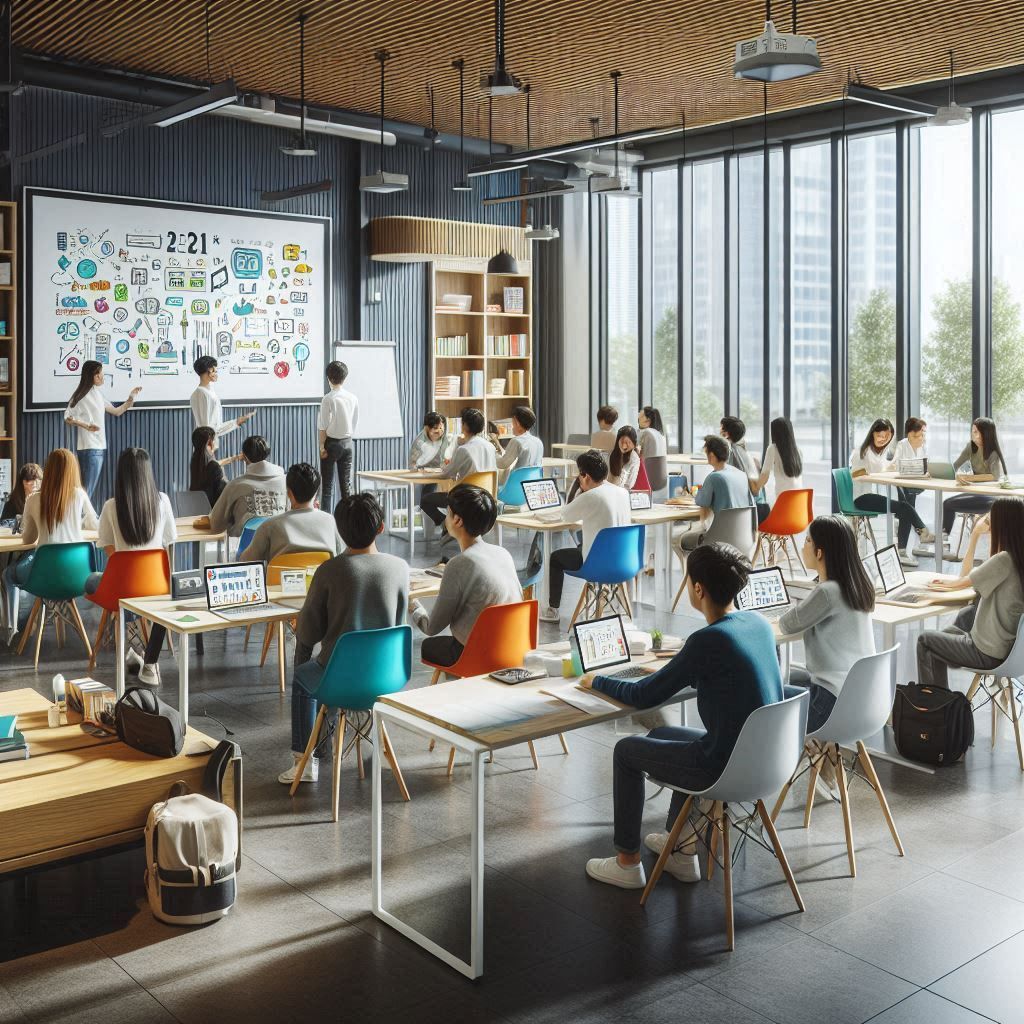@Ana_moderator In flipped classroom teaching students face difficulty regarding language because English is their second languge so their learning pace is slow.
In traditional teaching students learn first and practice at home whereas in flipped classroom teaching students learn on their own first at home and practice in class later. In this way teach add what they have not learned on their own at home.
-
Traditional VS flipped classroom for adaptive and individualized learning
-
In traditional classrooms, the teacher typically delivers lectures during class time, and students are then expected to complete homework assignments outside of class. This model often follows a one-size-fits-all approach, where all students receive the same instruction at the same pace. In contrast, the flipped classroom model reverses this dynamic. Students engage with instructional materials, such as pre-recorded lectures or readings, outside of class, freeing up in-class time for more interactive and collaborative activities. This allows teachers to tailor their instruction to individual student needs and provide more personalized support. In the context of adaptive and individualized learning, the flipped classroom model can be particularly effective, as it allows for greater flexibility and customization of the learning experience to accommodate diverse learning styles and paces.



"Empowering students through engaging education, fostering environmental consciousness, and advancing scientific literacy. Committed to shaping future leaders in Life and Earth Sciences."
-
Hi, in my experiences after the covid pandemic, the flipped classrooms given more important to overcome certain problems such students attendants, their interest in using gadgets and duration availability of the lessons to complete. Of course the attraction in flipped classrooms more effectively compare to traditional classrooms. More over, globally there is education transformation focused to ICT based classrooms created more to flipped based classrooms.
-
Flipped Classroom is a teaching approach that reverses the traditional lecture-homework format. Here's a comprehensive overview:
What is Flipped Classroom?
In a Flipped Classroom, students:
- Learn basics at home: Watch videos, read texts, or complete online modules to learn fundamental concepts.
- Work on activities in class: Engage in hands-on activities, discussions, and projects that apply what they've learned.
Benefits:
- Personalized learning: Students learn at their own pace, and teachers can provide targeted support.
- Increased engagement: Students are more engaged in class, as they're working on activities that apply what they've learned.
- Improved retention: Students retain information better, as they're actively applying it.
- Better use of class time: Class time is used for hands-on learning, rather than lecturing.
- Enhanced collaboration: Students work together on activities, promoting teamwork and communication.
Implementation steps:
- Record video lectures: Create video lectures or find existing ones that cover basic concepts.
- Assign pre-class work: Assign students to watch videos or complete online modules before class.
- Design in-class activities: Create hands-on activities, discussions, or projects that apply what students have learned.
- Provide support and feedback: Offer guidance and feedback as students work on in-class activities.
- Monitor progress: Track student progress and adjust instruction as needed.
Tools and resources:
- Video recording software: Use tools like Camtasia, Screencast-O-Matic, or Khan Academy.
- Learning Management Systems (LMS): Utilize LMS like Canvas, Blackboard, or Moodle to assign pre-class work and track progress.
- Online collaboration tools: Use tools like Google Docs, Trello, or Asana for in-class activities and group work.
By flipping the classroom, teachers can create a more engaging, personalized, and effective learning environment for their students.
-
@Ana_moderator, @ASGHAd210770cb3, @Bousl2336873cb4, @MYLOG47799627c6, @Yousuf-Memon
Aslam o alaikum and hello every one,In my perspective flipped class room has more grip in learning of student, although traditonal classroom have also its impacts of learning. Let me make it more clear.
As we all know that in a traditional classroom, the teacher primarily delivers lectures during class time, with students absorbing information and then completing assignments or studying at home. This approach is familiar and straightforward, making it easier to manage in settings with limited resources, such as in many schools including Pakistan. However, it often provides limited opportunities for individualized attention and adaptive learning, as the pace is usually set by the teacher and must accomodate to the average student.
Now in flipped classroom the same module disscussed above is inverted, although I am not experienced in this module but seen videos in pandemic days. In this module Student has to learn from videos made by teacher, which student can play, pause, or review or replay again. It means here the pace has to set by a student. Every individual student has to decide at his own in context of learning. This is called adaptive and individualised learning.
Actually If we are interested in adaptive and individualised learning then our approach must be towrds flipped classroom. ** Also mind that a student must have access to all educational material needed for flipped classroom, and he/she must have a good understanding of using that material.** Un fortunately in Pakistan average students have these kinds of commands.
Zeeshan Mahboob
High School Teacher
Government Boys Higher Secondary School Dando
Taluka Tando Ghulam Hyder
District Tando Muhammad Khan
Province of Sindh
Pakistan
Cell # 0092 336 214 9427
email: kingasadking921@gmail.com -
@Ana_moderator
Flipped classroom model replaced the traditional classroom because FC emphasizes active learning which means it engages with discussions, problem-solving, and collaborative activities, which can lead to deeper understanding compared to passive learning like lecture mode. The things that need to be given attention is that all students may have equal access to the necessary technology at home, such as computers or reliable internet connections. Poor socio-economic background parents facing problems. Secondly, are all students, especially the primary children disciplined to access the assignments on time? Good parental care is needed here. But both parents are busy with their work. These are the main problems I am facing while implementing the flipped classroom in my school. So, finally I'm doing partial flipped classroom. -
The flipped classroom model significantly differs from the traditional approach by having students engage with instructional content at home and dedicating class time to interactive activities and personalized support. In this model, teachers act more as facilitators, guiding students through discussions and problem-solving, which increases individual and group interactions. Students are more actively engaged in learning, collaborating with peers, and taking responsibility for their education. The self-paced nature of the flipped classroom allows students to review materials as needed and address any difficulties during class time. Technology is essential for accessing pre-class content, necessitating reliable internet access. Continuous assessment and immediate feedback during class activities are key features, promoting ongoing learning and understanding. Overall, the flipped classroom fosters a more dynamic, interactive, and personalized learning environment, encouraging deeper engagement and independence in students.
-
@Ana_moderator Aslam o alikum mad Hi Ana
Some time when I use flipped class room I observe that in Traditional Classroom the Class time is primarily used for direct instruction and lecturing.while in Flipped Classroom Class time is used for interactive, hands-on activities, discussions, and applying knowledge.
Traditional Classroom Students are passive recipients of information.while in
Flipped Classroom Students engage with content actively before class, allowing for more dynamic and participatory class sessions.
By adopting the flipped classroom approach, educators aim to create a more engaging, personalized, and effective learning environment for students. -
@Ana_moderator flipped in other words we can say active learning method which is student centered method only teacher is not bound to share but students also has right to present bundle of ideas regarding the topic they do advance study at homes this is what we called modern flipped active learning am i right agree?
-
@Ana_moderator flipped classroom more effective than traditional method
-
@Engr-Zeeshan thank you so much
-
@Bousl2336873cb4 informative
-
@MYLOG47799627c6 I agree with you
-
Are your students fully engaged during class? How can you transform your teaching approach to enhance learning and interaction?

The flipped classroom model might be the answer. This approach reverses traditional teaching by having students learn new content at home and use class time for interactive activities.
Here’s a comprehensive look at how to implement this model effectively with innovative techniques.
What is a Flipped Classroom?
A flipped classroom reverses traditional lecture and homework elements. Students first engage with instructional content outside of class (e.g., via videos or readings) and then use class time for active learning and problem-solving.
Benefits:
Enhanced Engagement:
Students arrive prepared for deeper discussions and applications.
Increased Flexibility:
Allows students to learn at their own pace and revisit content as needed.
More Interactive Class Time:
Focuses on collaborative and hands-on learning.
Innovative Techniques for Flipping the Classroom- Interactive Video Lectures:
Technique: Use platforms like Edpuzzle or PlayPosit to create interactive videos with quizzes and prompts.
Idea: Embed formative quizzes within videos to check comprehension before class. - Curated Online Resources:
Technique: Develop a repository of articles, podcasts, and simulations related to the topic.
Idea: Organize resources using tools like Google Classroom or LMS.
3.Peer Teaching:
Technique: Have students create and present their own explanations or presentations on a topic.
Idea: Students produce short videos or slideshows for peer review. - Gamification:
Techniques: Incorporate game elements such as points, badges, or leaderboards for completing pre-class tasks.
Idea: Use platforms like Kahoot! or Quizizz for engaging quizzes. - Flipped Mastery:
Technique: Implement mastery-based learning where students must demonstrate understanding before moving on.
Idea: Use online assessments or discussion forums for feedback. - Collaborative Learning Spaces:
Technique: Design activities that emphasize group work and problem-solving.Idea: Use stations or breakout groups for collaborative projects.
Idea: Use stations or breakout groups for collaborative projects. - Real-Time Feedback:
Technique: Use digital tools for immediate feedback during class, such as live polls or collaborative documents.
Idea: Tools like Padlet or Google Forms for instant feedback. - Flipped Field Trips:
Technique: Create virtual field trips or simulations for exploration before class.
Idea: Utilize resources like Google Expeditions or virtual labs. - Student Choice and Autonomy:
Technique: Offer students options for pre-class materials based on their learning preferences.
Idea: Provide choices such as videos, readings, or interactive content.
Implementing the Flipped Classroom Model - Plan and Structure:
Design clear pre-class content and in-class activities.
Ensure pre-class materials are accessible and engaging. - Communicate Expectations:
Explain the flipped classroom model and set clear expectations for preparation and participation. - Provide Support:
Offer additional help and resources for students who need it, such as tutoring. - Assess and Adapt:
Regularly evaluate the model’s effectiveness and adjust based on feedback and learning outcomes.
Could the flipped classroom model enhance your teaching effectiveness? By flipping the traditional approach, you can foster a more interactive and engaging learning environment. Implementing these innovative techniques can help create a dynamic classroom that better supports student learning and participation.
By Tabassum Laghari
Tabassum Laghari
Science Teacher
Sindh, Pakistan - Interactive Video Lectures:
-
@Tabassumlaghari This method is amazing as Flipped learning is a methodology that helps teachers to prioritize active learning during class time by assigning students lecture materials and presentations to be viewed at home or outside of class. One of the most exciting advancements in the modern classroom is flipped learning.
-
@Ana_moderator After practicing flipped classroom approach in education the major differences I see is that, A flipped classroom reverses the traditional teaching role where the lessons are first taught, and then homework is assigned. Instead, the students first study the course material, typically through online lectures, then learn how to implement what they learned in a classroom setting.
-
Traditional classroom are teacher centred, where teacher deliver lecture to the students to gain knowledge and receive information.
In which Text books, notebooks and other paperwork used.
Flipped classroom are Student centred,where students access lectures and other contents at home and discuss hands on activities using classroom. In this video lectures and other online resources are used.
Now, here I am sharing some points of Using Technology classroom.
A Technology classroom can be both Teacher centred and student-centered, with technology integraty into lessons. in which tablets, computers, online tools and educational softwares are used. It's engagement is higher due to interactive content and multimedia.Which classroom will you prefer
(FARHAN MEHBOOB)
Primary School Teacher
SINDH, PAKISTAN -
@FarhanMehboob Aslam o Alaikum dear brother,
Each type of classroom has its own benefits. Traditional classrooms offer direct teacher-student interaction. Flipped classrooms let students learn at home and use class time for practice. Technology classrooms use digital tools to make learning interactive.
I think the best choice depends on what works best for the students and the lesson goals. Combining these methods might be the most effective way to teach.
I hope you got my point.
RegardsZeeshan Mahboob
High School Teacher
Government Boys Higher Secondary School Dando
Taluka Tando Ghulam Hyder
District Tando Muhammad Khan
Province of Sindh
Pakistan
Cell # 0092 336 214 9427
email: kingasadking921@gmail.com -
@Sehar-Kazi
In flipped classroom approach the students are required to learn any new topic or unit or lesson or chapter by themselves at home and on the next day in real classroom they show their performance of learning before teacher. The teacher addds those things which they have not learnt by themselves. In this way the concept of that new topic or unit or lesson or chapter becomes clear in their minds. So I think flipped classroom approach is very effective apprach of learning. This approach makes students independent learners. They neither rely upon others nor copy from others. As being a teacher it is our experience when we assign any work to students to do many of the students only copy from other students. If there are mistakes in their works the mistskes are in the work of those students who have copied from others. -
@FarhanMehboob
Boths approaches have their own importance. The flipped classroom approach makes students independent learner. We should combine both approaches. The students should bd required to learn any new topic by themselves at home and on the next day in resl classroon they should be asked to show their performance of learning before teacher. The teacher then add those things which students have not learned by themselves. As all students can not learn fully by themselves. Again teacher's role is very important. Without a teacher students can not learn fully. Flipped classroom approach makes students independent learner only. In this approach students can not fully. Again need of teacher is very important. So we should combine both approaches. Wher there is facility of digilal technology in classroom it should be utilized. Again the learning will be interesting and effective.